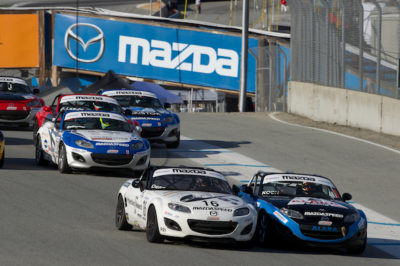From the beginning, Mazda knew the importance of balanced performance and controlling cost in the MX-5 Cup series. By Jason Isley
This feature is part of a special series running on racer.com about the SCCA Pro Racing Idemitsu Mazda MX-5 Cup Presented by BFGoodrich® Tires as Mazda Motorsports, racers and fans anticipate the 2016 MX-5 and the MX-5 Cup. MazdaMotorsports.com will keep you up to date with all the latest news and milestones as Mazda and its partners develop the 2016 MX-5 race car, currently underway.
When the first SCCA Pro Racing Mazda MX-5 Cup car rolled out of the dealer showroom, it did so wearing a complex set of engine seals on its 2.0-liter Mazda MZR engine, which would help ensure a level playing field for all who joined the series.
As the program and series evolved, world-renowned engine builder Comptech USA was brought in to evaluate and seal the engines for Mazda. “We dyno them to ensure they are within the one percent, then install the seals,” says Tony Manzer, engine builder at Comptech USA. “They get a new part number put on, then we ship them back to Mazda.”
The sealed engine comes in at a very cost-effective price when compared to even a mildly prepped race engine, and can only be sourced from Mazdaspeed Motorsports. “It’s $3,745 plus freight,” says James Painter of Mazdaspeed Motorsport Development.
The program removes one of the areas that can cause racing costs to skyrocket, and helps make MX-5 Cup a true driver’s series – it is a great comfort knowing you wont get out powered on the straights by someone who spent more money under the hood.
The one-percent window of power that Comptech strives for means you wont find people buying up a number of engines looking for that strong outlier, and the Mazda durability is seeing teams utilize the same engine season after season. “I don’t think they have been buying them very often since the later motors have improved valve springs so they survive missed shifts better,” says Manzer. “If they take care of them, they can run the motors for a couple of years.”
In a direct case of racing helping to improve the brand, Mazda was able to look at data from the early MX-5 Cup cars and make improvements to aid durability for it and the road-going MX-5.
“There are two generations of engines; the 2006-’08 was the older-generation engine,” Mazdaspeed Specialist Mike Allen explains. “The 2009 and later engine has the same horsepower rating, the torque ratio is exactly the same, but they did upgrade some of the parts for durability purposes – they went to a forged crank, forged rods, different valve springs. Ever since they went to that generation engine, the 2009 and later, we really don’t see failures. As far as a regular frequency interval, I couldn’t tell you – they don’t replace them often enough to really have any data to go back on. Every once in a while a team will order a new one.”
With all of the NC MX-5 engines being interchangeable, the early cars still competing in MX-5 Cup can be fitted with the updated engines, giving them the same piece of mind, and durability, as the newer cars.
Having such durable and reliable power allows MX-5 Cup teams to focus on other areas during the race weekend, and certainly helps them save money. “Last year I was talking to one of the teams [and] they have one of their cars that is going on four years with the same engine,” says Allen.
Related Content:
The Long Road
Take the (MAZDASPEED Pro) Challenge
Life After the Cup with Kenton Koch


 ACCESSIBILITY
ACCESSIBILITY